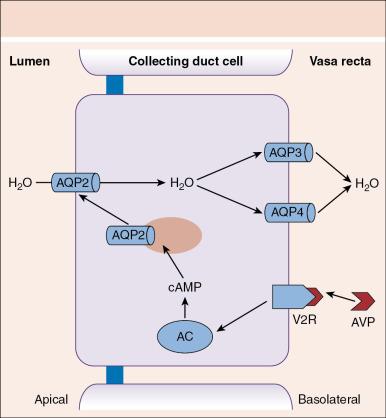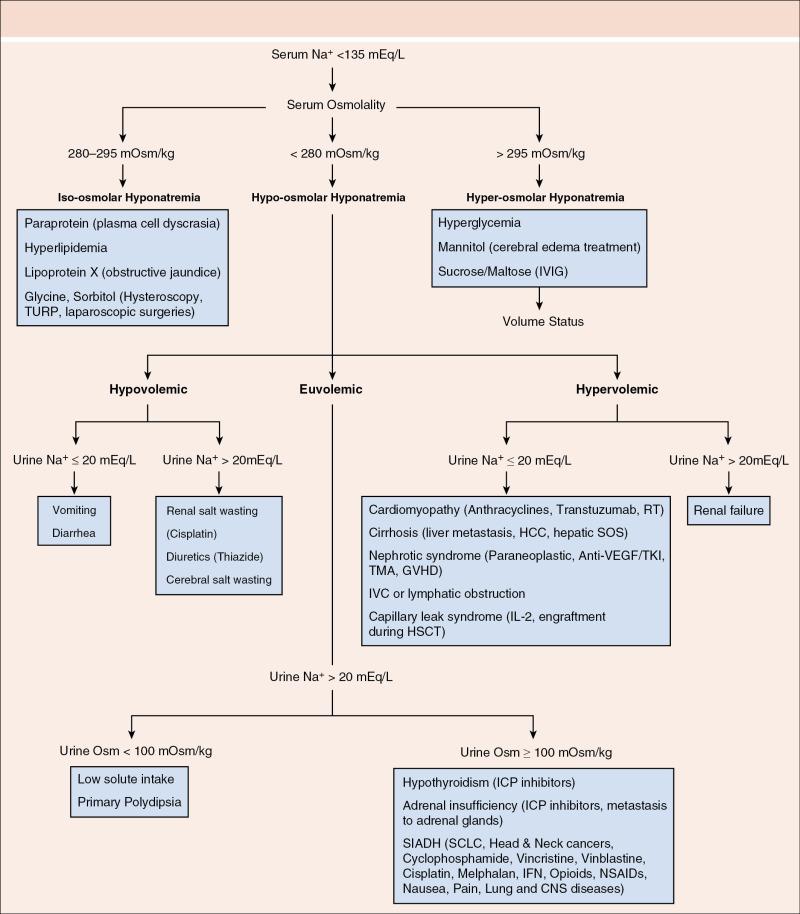Physical Address
304 North Cardinal St.
Dorchester Center, MA 02124
Hyponatremia is the most common electrolyte abnormality observed in cancer patients. In a retrospective cohort study from a comprehensive cancer center, hyponatremia (serum Na + < 137 mEq/L) was noted in 47% of hospitalized cancer patients [VO2]. In general, hyponatremia is categorized as mild (130–134 mEq/L), moderate (120–129 mEq/L), and severe (< 120 mEq/L), according to serum sodium concentrations. Hyponatremia has been linked to poor prognosis in several types of cancers, which include non-small cell lung cancer, pleural mesothelioma, renal cell carcinoma, gastrointestinal cancer, and lymphoma. , The risk of mortality increases with more severe hyponatremia. Moreover, low serum sodium concentrations have also been associated with poorer performance status in lung cancer patients. In addition, timely and effective corrections of serum sodium concentrations have been associated with improvement in prognosis for several cancers. ,
Symptoms of hyponatremia are caused primarily by osmotic swelling of brain cells and increased intracranial pressure (ICP). Severity of symptoms usually correlates with the degree of hyponatremia. Most patients with mild to moderate hyponatremia are asymptomatic. Severe hyponatremia, on the other hand, may cause nausea, vomiting, confusion, falls, movement disorders, seizures, and coma. Time course of the development of hyponatremia is another significant factor that determines the severity of symptoms. Chronic hyponatremia (onset > 48 hours) can be asymptomatic whereas acute hyponatremia can manifest as encephalopathy, especially in patients with malnutrition, hypokalemia, alcoholism, or advanced liver disease.
Hyponatremia is the result of imbalance between salt and water concentrations with relatively more total body water (TBW) than salt. Normal kidneys can eliminate up to 20 to 30 L of free water daily. Antidiuretic hormone (ADH) also known as arginine vasopressin ( AVP ) is the major hormone that regulates free water reabsorption by kidney tubules. ADH is a peptide hormone produced by the hypothalamus and transported to the posterior pituitary via nerve axons. It is released into the circulation from the posterior pituitary and binds to V2 receptors at the basolateral side of the collecting tubules in the kidney. Binding of ADH to V2 receptor activates adenylate cyclase and subsequent formation of cyclic adenosine monophosphate (cAMP). This leads to movement and fusion of specific vesicles that contain aquaporin 2 (AQ2) channels in the cytoplasm to the apical membrane of the collecting tubules. Once AQ2 channels are inserted, the apical membrane becomes permeable to water. Water moves from medullary renal space to the apical membrane and is then released into the circulation through the basolateral membrane ( Fig. 2.1 ). ADH release is stimulated by two mechanisms: osmotic and nonosmotic factors. The osmotic regulation of ADH occurs in the anterior hypothalamus as “osmoreceptor cells or osmostat” sense changes in extracellular fluid (ECF) osmolality. This is a tightly controlled system as an increase or decrease in ECF osmolality by 1% stimulates or suppresses ADH release respectively. Nonosmotic stimulation of ADH release occurs in the absence of changes in serum osmolality. Pain, emotional stress, nausea, and reduction in effective arterial blood volume (EABV) are some of the examples of nonosmotic stimuli, which tend to be very common in patients with cancer and those under treatment with various cancer therapies.

Hyponatremia typically develops when there is disruption in the elimination of free water by kidneys, or when water shifts from the intracellular to extracellular space, both of which result in the dilution of extracellular sodium concentration. Several algorithms are considered acceptable when evaluating a patient with hyponatremia. The most commonly used algorithm incorporates both serum osmolality and urine sodium concentrations. We have adopted this approach for specific causes of hyponatremia in cancer patients ( Fig. 2.2 ).

The first step in a patient with hyponatremia is to check serum osmolality. Serum osmolality is normally tightly maintained between 280 to 290 mOsm/L. Using this range, hyponatremia can be classified as hyper-osmolar, iso-osmolar, and hypo-osmolar hyponatremia.
If serum osmolality increases because of an effective osmole other than sodium, then hyper-osmolar hyponatremia develops as the effective osmole causes water shift from intracellular to extracellular space. The most common example of this kind of hyponatremia is caused by hyperglycemia. For each 100 mg/dL increase in plasma glucose, above 150 mg/dL 1.6 to 2.4 mEq/L decrease is observed in serum sodium concentration. Hyperglycemia over time can also stimulate thirst and ADH secretion by causing low EABV secondary to osmotic diuresis.
Hypertonic mannitol infusion, which is used in the treatment of cerebral edema, or sucrose/maltose carrier used in intravenous immunoglobulin infusions can also increase serum osmolality and subsequent movement of water from intracellular to extracellular space.
Hyponatremia in the setting of normal serum osmolality is called pseudohyponatremia . Pseudohyponatremia is caused by circulating excessive proteins or lipids, which reduce the water fraction of the serum. Because sodium is restricted to the water phase of the serum, laboratory methods that measure the sodium concentration per unit of total serum give falsely low measurement. However, analyzers that directly measure the sodium concentration or activity in the water phase of serum are not affected by this error. This measurement technique avoids dilution steps and is called direct potentiometry . Pseudohyponatremia in cancer patients can be seen with plasma cell dyscrasias (i.e., multiple myeloma, Waldenstrom macroglobulinemia) because of excessive paraproteins or in obstructive jaundice because of increased amount of abnormal lipoprotein, Lipoprotein X.
Another example of iso-osmolar hyponatremia is the use of glycine or sorbitol during hysteroscopy, transurethral resection of the prostate or laparoscopic surgeries as these isosmotic solutions may get systemically absorbed and cause the dilution of the extracellular sodium without changing the serum osmolality.
When serum osmolality is low, ADH release and subsequent hyponatremia can occur through nonosmotic stimuli of ADH. As reduction in EABV is one of the most common reasons of nonosmotic stimuli of ADH, evaluation of hypo-osmolar hyponatremia mandates assessment of volume status to differentiate the underlying causes. This type of hyponatremia can be further classified as hypervolemic , euvolemic , and hypovolemic .
Become a Clinical Tree membership for Full access and enjoy Unlimited articles
If you are a member. Log in here